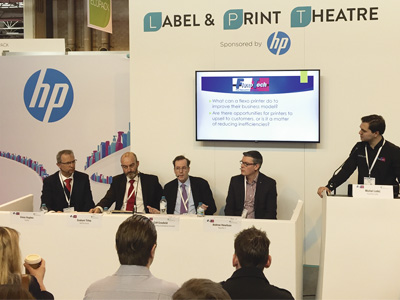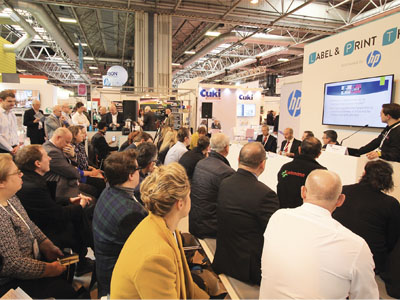Standing room only for the Flexo Debate
As always Packaging Innovations this year delivered a diverse mix of exhibitors from the expected to the slightly left of field. This show continues to be a networking melting pot with ideas and perspectives thrown in from the whole supply chain. Michal Lodej reports.
Packaging Innovations is not the type of show where you would expect to see printing machinery in action, however there was a Roland wide format printer working as part of a proofing and mock up system from Oris Packaging.
Toby Burnett, of Oris Packaging Innovations said, ‘The system can be used for mock ups or for proofing as it is able to recreate an almost identical replica of the finished item. This in part is due to being able to use the same printing stocks that run on a flexo press.’
Heiner Muller, key account director Europe, explained why proofs need to be so accurate, ‘People have a tendency to need to visualise the final product. This solution will help printers trying to get closer to the brand owners with much better proofs and mock ups.’
The company currently only has a small installed base in the UK, but has almost 400 installations worldwide.
Mr Burnett added, ‘Over two thirds of those installs are not just mocking up products but are also using it to create proofs as well. People try and interpret what a proof is, and it is actually contract between the printer and customer. So, it has to be as accurate as possible. Trying to produce proofs of this standard, on a conventional press could cost hundreds and hundreds of pounds before the customer even signs a contract.’
‘We are using a Roland machine, but this isn’t just a wide format printer, this is wide format on steroids,’ Mr Muller joked. ‘What turns it into a high-quality proofing machine is the use of ORIS-XG inks which widen the colour gamut to achieve 98% of the Pantone colour range. We try to copy the production environment as closely as possible.’
Mr Burnett, ‘Using this to create colour accurate mock ups means that brand owners can make decisions quicker, this obviously gives them a much quicker time to market, which they love as delays to getting their product to market can cost thousands. It also helps reduce waste which helps on eco-friendly commitments.’
Flexo debate returns
The Flexo Debate this year returned to look at the challenges and opportunities facing the flexographic industry. On the panel was Vince Hughes, coating and technical manager (UK) from Interket; Andrew Hewitson, managing director at Reproflex 3; Graham Tilley, managing director at InterFlex Group; and Cliff Crosfield, an independent printing and packaging consultant.

The debate looked at a number of challenges facing the flexo market today
What can a flexo printer do to improve their business model, are there opportunities for printers to increase services to upsell to customers, or is it now purely a matter of reducing inefficiencies to be more profitable?
Mr Crosfield took the view that printers could possibly upsell by simply being more proactive when marketing their own services, ‘There are a number of factors for printers to look at but particularly from engaging with end users. I think there is an opportunity for printers to convey in an active way what they do. Companies have websites, but newsletters and case studies are a good way of showcasing the innovative jobs printers have done and how you have found a solution for the end user.’
Mr Hughes gave an example of what Interket have done to hit both the birds with one stone, ‘We have introduced VMI, Vendor Management Inventory, we found that you can take the hassle from stock supply from your customer, not only does it make create better production planning because you are not reliant on erratic production orders, which totally upsets production plans, but taking that hassle away is appreciated by the customer and allows a much more personal relationship with them as well as far less unnecessary down time and a better projection of orders.’
Mr Tilley saw the two sides as part of the same problem, ‘The two things go hand in hand, there are opportunities to upsell but you have to continually look for ways for which you find business improvement to maintain margins. If you manage to get a robust relationship with blue chip clients they will want to see long term plans for improvement in efficiencies and this type of thing, so you need to invest in new technologies to enhance efficiency, you also need to look at your workforce, just to defend your margins and to also cover your cost of living increases.’
Mr Hewitson raised the issue of not being able to pass o on cost improvements to customers, ‘It becomes a problem when we’re not seeing an increase in the value of our product while at the same time having to continually invest in the latest technology to keep up with clients demands. And that’s the big challenge that everyone in supply chain is facing. With the imaging technology, we now have at our disposal, we have more possibilities than ever, if you think outside the box with it. If you can use it to create a finer grade product with a little bit of added value, you’re not increasing the cost but you are putting value into your production process.’
Is the digital vs flexo debate sensationalist or do you feel there is genuine risk that digital, or any other printing process, will become so profitable that flexo as a technology won’t be able to compete was the next question put to the panel.
Mr Tilley began, ‘I think that in wide web production at the present moment in time, its sensationalist. With any new technology, there are early adopters and there are niches which clearly define great opportunities to fully differentiate yourself, there is definitely a market for that. But we looked at it in depth, and we could probably only get about a 30% utilisation [of a digital press] from our current product demand and we’re not a small company.’
Mr Hughes added, ‘Honestly there’s certainly space in the industry for both technologies from a long run, high volume production of labels, there’s no room at the moment in our current business there’s no room for short run digital work. I appreciate that if you are a short run producer then there’s definitely advantages there to go digital, but these machines are hungry mouths to feed, I can buy a fantastic conventional press for the equivalent cost of a digital press and I know I’m going to get far more value out of a conventional press.’
Mr Crosfield drew comparisons with the commercial printing market, ‘If you look at litho a few early adopters moved in to try the digital presses, and there was a cost/run length correlation. So short runs would go digital, long runs would go litho. You find that there’s much more of a balance now, most litho operations will have digital presses, and in some cases in equal proportions. As the digital speeds increase, in both sheet and web formats, the date and point is starting to close. At some point in time, it will present a real challenge to conventional speeds.’
Having the right technology for the correct market was important to Mr Hewitson, ‘If you look at the whole digital workflow, the return on the investment from the pre-press point of view is something we’ve had to deal with as a pre-press company for years now and a three to five year payback on a piece of equipment is quite a challenge, compared to a conventional press. If you are going to step into that market, I think if you have the business plan such as the funkypigeon.com or printing the morning newspaper on packaging, that’s obviously a place where digital is perfect.’
Flexo advances
Mr Crosfield spoke of how improvements in flexo have opened up new applications, ‘Part of what I do is brand protection and anti-counter fitting, and one of the constraints that we have found over time is the imaging capability of certain processes. However now I’m seeing print which can go down to mezzotint, it can do very highlight screening, it can avoid dot bridging at the mid tones, it then opens up areas of putting in technologies which can authenticate products.’
Mr Tilley believes that quality should always be a given, ‘if you don’t have quality you will lose work very very quickly. It is an interesting thing to ask yourself, what is a qualifier and what is a winner of a contract, and I would suggest that quality is a qualifier, ie it gets you an invite to the race, but rarely has anybody won a contract because their quality is brill. Quality is a given and certainly the idea of charging a premium for it is even rarer still.’
This was an idea Mr Hughes agreed with strongly, ‘There is no question about that you will very quickly lose business if your quality is poor, repro now is so fantastic that what we are achieving on flexo presses is phenomenal it’s a wonderful era of flexo machinery, the presses are fantastic at the moment, delivering work which in my mind is as good as any litho work, in labels anyway. To actually ask a customer for more value for your product, well it’s not going to happen, but you can bet your life if you have an ageing press that is not delivering the quality expected today, then you will struggle to maintain business.’
Mr Hewitson concluded, ‘Flexo has learnt a lot in the last five years and a lot of the tools, the inks the aniloxes and even the press configurations are now working as a system and I think that, when we talk about this cost versus quality I think that is still a debate to be had, my quality and my consistency will gain you efficiencies and as a system overall, and you will have a better business because of it.’
Read the full online edition of FlexoTech magazine here






